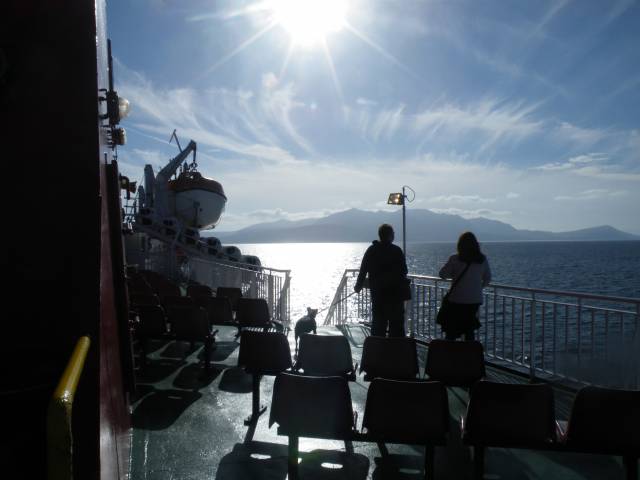#ScottishIsles – Caledonian MacBrayne’s (CalMac) ferry route to the Isle of Arran, dubbed Scotland in miniature, and to the Mull of Kintyre, provides a ‘gateway’ particularly for Irish visitors, given the proximity of the south-west region, writes Jehan Ashmore.
Among the Forth of Clyde services is the popular Ardrossan-Brodick (Arran) route and the added option of continued exploration further west with the Ardrossan-Campbeltown (Mull of Kintyre) service. Either route, presents an introduction to the wonders and wilderness of these areas and more of the Western Isles. CalMac have an extensive car ferry route network and multiple-destination tickets ideal for island-hopping.
Travel as a motorist or as a foot-passenger by beginning at Ardrossan on the Ayrshire coast which is easily accessible by road or bus (via Ayr) having taken sailings from either North Channel ports to those on Loch Ryan, Scotland. There’s a choice between Belfast-Cairnryan, Loch Ryan Port (Stena Line) and Larne-Cairnryan (P&O Ferries) services.
Arran offers a wondrous mix of mountains, forests, lochs, sandy beaches and a whisky distillery. All of this can be reached by taking the Ardrossan-Brodick ferry of only 55 minutes duration. The year-round route’s mainstay, Caledonian Isles (1993/5,221grt) in the high-season is supported by additional capacity from Isle of Arran (1984/3,296grt). In addition the first drive through roll-on roll-off ferry built for CalMac, sails the seasonal Mull of Kintyre route that runs up to late September.
Alternatively, the short cut from Arran back to the mainland, albeit missing out on the Kintyre Peninsula, is by taking from the north of the island the short-hop on board Loch Tarbert (1992/211gt).This smaller ferry plies between Lochranza and Claonaig, that lies south of Tarbert. This option, also requires a drive northwards before heading south to Glasgow and returning to ferryports on Loch Ryan.
Facilities on board the Ardrossan serving ferries include a ‘Mariners’ restaurant with an emphasis on locally produced food, a giftshop, bar and lounges with forward facing views. On that note, the open deck spaces to soak up these views, unlike the cross-channel ferries, was a most welcomed feature.
The short passage from Ardrossan to Brodick, Arran across the Forth of Clyde presents views of both mainland and that of the looming dominance of the island’s mountain, Goat Fell. The peak of 874m / 2,866ft towers above Brodick Bay.
The Fair Trade island's main town Brodick, has hotels, cafe and gift shops lining the waterfront and nearby sandy beach. On a recent visit, offshore, day-tripper yachts were moored and were joined by an evening arrival of an impressive private three-masted schooner. The yacht took advantage of the sheltered anchorage to overnight in the bay. In the distance thick forests surround Brodick Castle & Gardens, an 800 year-old highland estate, the UK’s only island country park which is open to the public.
The Mull of Kintyre route, Ardrossan-Campbetown, takes only 2 hours and 30 minutes and on this connection (saving on distance, time and fuel) affords further views off the south coast of Arran. Noting on Saturdays only and in the reverse direction, the ferry departs from Campbeltown to firstly make an en route call to Brodick, Arran before continuing the crossing to Ardrossan.
The approaches to Campbeltown begins with another imposing feature, the steep sided Davaar Island at the entrance to an inlet leading to the port. The harbour is home to a mix of fishing fleet and leisure boats at the marina located conveniently in the centre of the town.
Berthed at the marina, was a ‘passenger-only’ RIB ferry of operator Kintyre Express, which offers an alternative direct service to and from Northern Ireland, on the route out of Ballycastle, Co. Antrim.
It was from the Kintyre coastline could be seen south the ‘North’. In the other direction while taking the Glasgow bound bus were more isles: Gigha, Islay and Jura. An en route stop was made at the stunningly spectacular inland coastal location of Inveraray, on Lough Fyne in which Afloat.ie will have a further report.































































